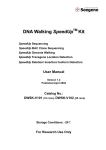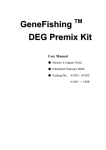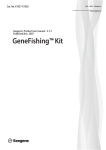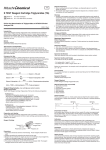Download cDNA Isolation Kit
Transcript
cDNA Isolation Kit User Manual Version 1.1 Catalog No. FDRK-2101 Storage Conditions: -20℃ For Research Use Only Product Warranty and Liability Seegene warrants the performance of all products as described when used according to instruction. Any problem incurred for any reason, other than misuse, should be reported to Seegene immediately. This warranty limits our liability to replacement of the products. Safety Warning and Precautions This product is limited for research use only, not recommended or intended for diagnosis of disease in humans or animals. Do not use internally or externally in humans nor animals. Ordering Information and Technical Services Seegene USA P.O. Box N Del Mar, CA 92014-0376 USA Tel : + 858-610-9610 Fax: + 858-623-9610 E-mail: [email protected] URL: www.see-gene.com Seegene, Inc. 142-21 Samsung-dong, Kangnam-gu Seoul, 135-090 Korea Tel: + 82 2-566-9830 Fax: +82 2-566-9831 E-mail: [email protected] URL: www.see-gene.com The PCR process is covered by patents owned by Hoffman-La Roche Inc. No license or immunity under any other patent is either expressed or implied by the sale of any Seegene product. 2 www.see-gene.com Table of Contents 1. Introduction -----------------------------------------------------------------------------2. List of Components -------------------------------------------------------------------3. Reagent and Equipment to Be Supplied by User -----------------------------4. Storage Conditions -------------------------------------------------------------------5. First-strand cDNA Synthesis -------------------------------------------------------6. PCR reaction for RACE A. Primer design ----------------------------------------------------------------------B. PCR for 5’ and 3’-RACE ---------------------------------------------------------7. Isolation of Full-length target cDNA ----------------------------------------------8. Troubleshooting Guide --------------------------------------------------------------Appendix A. Expected Result of 5’-RACE -----------------------------------------Appendix B. Expected Result of 3’- RACE ----------------------------------------Appendix C. Isolation of Full-length cDNA from RACE Fragments ---------Related Products -------------------------------------------------------------------------Seegene’s Distributors ------------------------------------------------------------------- www.see-gene.com 4 7 7 7 8 10 11 12 16 17 17 17 18 19 3 1. Introduction ACPTM Technology (patent pending) represents the most accurate and extensive technology developed by Seegene. The specificity with which a primer anneals only to its target sequence is the most critical factor. ACPTM Technology provides a primer with annealing specificity to the template and allows only real products to be amplified, such that it enables the researchers to find only real products as a result. First-strand cDNAs are synthesized using oligo dT-ACP, wherein the 3’-end core portion of the oligo dTACP comprises a hybridizing sequence complementary to a poly A region of mRNA transcripts. CapFishingTM cDNA Isolation Kit provides methods for performing 5’- and 3’-rapid amplification of cDNA ends (RACE) without a complex series of enzymatic steps (adaptor ligation and second strand cDNA synthesis). Full-length first-stranded cDNA synthesis Seegene’s CapFishingTM cDNA Isolation Kit provides a simple and fast method for generating full-length cDNAs during reverse transcription reaction. First, first-strand cDNAs are synthesized using oligo dT-ACP. Second, when reverse transcriptase recognizes the CAP structure of mRNA, which is present at its 5’-end for its stability, Seegene’s CapFishingTM adaptor sequence is linked to the 3’-end of the first-stranded cDNAs (CapFishingTM technology, patent pending) Only the full-length cDNAs have the Seegene’s CapFishingTM adaptor sequence at their 3’-ends and oligo dT-ACP sequence at their 5’-ends. Thus, the full-length cDNAs generated by CapFishingTM technology can be used directly in 5’- or 3’-RACE reactions without a complex series of enzymatic steps such as adaptor ligation and second-strand synthesis. 5’-end enriched first-stranded cDNA synthesis Seegene’s CapFishingTM cDNA Isolation Kit provides a simple and fast method for generating 5’-end enriched first-stranded cDNAs during reverse transcription reaction process. First, first-strand cDNAs are synthesized using random hexamer. Second, when reverse transcriptase recognizes the CAP structure of mRNA, which is present at its 5’-end for its stability, Seegene’s CapFishingTM adaptor sequence is linked to the 3’end of the first-stranded cDNAs. (CapFishingTM technology, patent pending) Thus, the 5’-end enriched first-stranded cDNAs can be used directly in 5’-RACE reactions without a complex series of enzymatic steps such as adaptor ligation and second-strand synthesis. If you want to clone the 5’-end region of large transcripts (>6 Kb) or 5’-end enriched cDNAs, you can use the random hexamer instead of oligo dT-ACP as cDNA synthesis primer. RACE PCR reaction For the 5’- or 3’-RACE PCR reaction, the sequence of a target gene was needed to 4 www.see-gene.com design target primers. Design the target primers to be about 20 ~ 24 bases in length, 60% GC content, with no secondary structure, and with no self-hybridization and forming primer dimmers at 3- ends. The primer design is described in detail below. Cloning and sequencing Both 5’- and 3’-RACE reactions are conducted using the first-stranded cDNAs generated by CapFishingTM Technology. Then, the full-length cDNA of a target gene can be directly obtained using the 5’- and 3’-RACE products without constructing or screening a cDNA library. The RACE products can be cloned directly into a cloning vector and their sequences are confirmed by sequence analysis. www.see-gene.com 5 RNA (Poly A or total RNA) First-strand synthesis using random hexamer First-strand synthesis using dT-ACP 5’-end rich cDNAs Full-length cDNAs PCR for 5’-RACE PCR for 5’- or 3’-RACE 5’-RACE fragment of target transcript 5’- or 3’-RACE fragment of target transcript Cloning and Sequencing Cloning of 5’RACE fragment Cloning and Sequencing Cloning of 5’- or 3’RACE fragment End-to-end PCR, Ligation, or Direct PCR Full-length cDNA of target transcript Figure 1. Overview of Full-length cDNA isolation 6 www.see-gene.com 2. List of Components 1 2 3 4 5 6 7 8 9 10 11 12 CapFishingTM adaptor solution (patent pending) Oligo dT-ACP (10 µM) ( 5’-CTGTGAATGCTGCGACTACGATXXXXX(T)18-3’ ) Random Hexamer (10 µM) 5’-RACE Primer (10 µM) ( 5’-GTCTACCAGGCATTCGCTTCAT-3’ ) 3’-RACE Primer (10 µM) ( 5’-CTGTGAATGCTGCGACTACGAT-3’ ) Control 5’-GAPDH Primer (5 µM) ( 5’-AGTGCCAGCCTCGTCCCGTA-3’ ) Control 3’-GAPDH Primer (5 µM) ( 5’-TGAGCCCTTCCACAATGCCA-3’ ) Control Total RNA (Mouse Kidney, 0.5 µg/ µl) dNTP (5 mM) dNTP (2 mM) BSA (1 mg/ml) DEPC-treated Water 3. Reagents and Equipment to Be Supplied by User Reverse transcriptase DTT RNase inhibitor Taq or Pfu DNA polymerase Thermal cycler 4. Storage Conditions Store control RNA below -70℃. Store all other reagents below -20℃. www.see-gene.com 7 5. Full-length First-strand cDNA Synthesis We recommend wearing gloves throughout to protect your RNA sample. Perform all reaction on ice unless otherwise indicated. For the proper full-length cDNA synthesis, we recommend using MMLV RNase H- point mutant (not deletion mutant) reverse transcriptase. 1. Add the following reagents to a tube for RT. Poly A+ or Total RNA ? µl 5 mM dNTP 2 µl 2 µl 10 µM dT-ACP or random hexamer DEPC-treated water ? µl 11.5 µl Note: For the cDNA synthesis, 1 µg ~ 3 µg of total RNA or 50 ng ~ 1 µg of poly A+ RNA can be used. If you want to clone the 5’-end region of a large transcript (>6 Kb) or to obtain 5’-end enriched cDNAs, we recommend using the random hexamer as cDNA synthesis primer. 2. Incubate the tube at 65℃ for 5 min. 3. Chill the tube on ice for 2 min and spin the tube briefly. 4. Add the following reagents to the tube from step 3. 5X RT buffer 4 µl 0.5 µl RNase inhibitor (40 u/µl) 0.1M DTT 1 µl BSA (1 mg/ml) 2 µl 1 µl Reverse transcriptase (200 U/µl) Total volume 20 µl Note: According to the kind of reverse transcriptase, DTT may be needed additionally. Note: We recommend you use a RNase H-, M-MLV reverse transcriptase. Reverse transcriptase without ribonuclease H activity prevents from degradation of RNA during 1st strand cDNA synthesis, resulting in higher yields of full-length cDNA from long templates. 5. Incubate at 42℃ for 1 hr. 6. Add 1.4 µl of CapFishingTM adaptor solution to the tube. Note: After the completion of at least 1 hour incubation, the CapFishingTM adaptor solution should be added into the tube containing the RT reaction mixture and reverse transcriptase. Before adding the CapFishingTM adaptor solution to the tube, preheat the CapFishingTM adaptor solution at 65℃ for 5 min and cool it down on ice for 2 min. 8 www.see-gene.com 7. Add 0.3 µl reverse transcriptase to the tube containing the CapFishingTM adaptor solution. 8. Incubate at 42℃ for 30 min. 9. Heat the tube at 70℃ for 15 min. 10. Incubate the tube at 94℃ for 5 min. 11. Chill the tube on ice for 2 min and spin the tube briefly. 12. Dilute the first-stranded cDNAs for the PCR reaction by adding 180 µl DEPC treated water. www.see-gene.com 9 6. PCR reaction for 5’- or 3’-RACE A. Primer design You have to design target primers for the 5’- and/or 3’-RACE reactions. You may have to design nested primers for real RACE products. The primers should be: 22 ~ 30 nucleotides long GC content > 50% Tm ≥ 65℃ The primers should have a GC content of 50 ~ 70%. The primers should not be able to form secondary structures due to internal complementarity. Avoid containing sequences at the 3’-end that allow base pairing with itself or other primer. Avoid repetitive sequence or regions containing stretches of the same nucleotide. Sometimes, the specificity of your PCR reaction may be low (high level of nonspecific background), resulting in mispriming and the generation of false amplification products. In this case, design nested primers to amplify an internal region of the original amplified product. Nested PCR increases sensitivity by reducing the nonspecific products. Region to be amplified by 5’-RACE Region to be amplified by 3’-RACE Overlapping region T(18) 3’ 5’-RACE primer 5’ 3’-RACE primer Figure 2. Relationship of target primers to a full-length first-stranded cDNA template. This diagram shows a synthesized first-strand cDNA (full-length cDNA). The target primers are designed to produce overlapping 5’- or 3’-RACE products. The spotted arrows indicate target primers for 5’- or 3’-RACE PCR. The blanked arrows indicate nested primers for nested 5’- or 3’-RACE PCR. 10 www.see-gene.com B. PCR for 5’- and 3’-RACE The optimal cycling parameters may vary with different polymerase, templates, target primers, and thermal cyclers. We recommend performing the control PCR experiment prior to the experiments with your samples. 1. Add the following reagents to a PCR tube for the PCR reaction. 5’-RACE 3’-RACE Diluted first-strand cDNAs Diluted first-strand cDNAs 2 µl 10X PCR buffer (MgCl2 free) 10X PCR buffer (MgCl2 free) 2 µl 25 mM MgCl2 2 µl 25 mM MgCl2 1 µl 10 µM 5’-RACE primer 10 µM 5’ target primer 1 µl 10 µM 3’ target primer 10 µM 3’-RACE primer 2 mM dNTP 2 µl 2 mM dNTP 0.2 µl Taq DNA polymerase (5 U/µl) Taq DNA polymerase (5 U/µl) Distilled water 9.8 µl Distilled water Total volume 20 µl Total volume Note: You can use Pfu DNA polymerase instead of Taq DNA polymerase. If you want to require high-fidelity synthesis, we recommend using Pfu DNA polymerse. 2. Commence the PCR reaction using the following program. Segment No. of cycles Temperature Duration 94℃ 1 1 3 min 94℃ 2 25~35 1 min 58~68℃ 40 sec 72℃ 1 min† 72℃ 3 1 5 min † If your target is longer than 1 Kb, you may increase the extension time. Note: 5’- and 3’-RACE using control total RNA was performed at 58℃ annealing temperature through 30 cycles. (See figure 6 in appendix C, 17page) Note: For the best results, hot start PCR technique is highly recommended in which the procedure is to set up the complete reactions without the DNA polymerase and incubate the tubes in the thermal cycler to complete the initial denaturation step at >90℃. Then, while holding the tubes at a temperature above 90℃, the appropriate amount of DNA polymerase can be pipetted into the reaction. The cycling parameters were optimized by using GeneAmp PCR System 9700. We recommend using ABI GeneAmp PCR System 9700 thermal cycler (Applied Biosystems). 3. Electrophorese 5 µl of the PCR products on 2% agarose gel stained with EtBr. www.see-gene.com 11 7. Isolation of Full-length target cDNA You can generate the full-length cDNA of your target gene by one of the following methods: z End-to-End PCR z Ligation of 5’- and 3’-RACE Fragments z Direct PCR using 5’- and 3’-RACE Fragments End-to-End PCR If you know the extreme sequences of the 5’- and 3’-ends of your target cDNA, you can use the sequences to design 5’ and 3’ primers for the generation of your target fulllength cDNA. The extreme sequences of the 5’- and 3’-ends can be obtained from the 5’- and 3’-RACE products of your gene that is generated by this kit as described in the Sections 5 and 6. 1. Design the gene-specific 5’ primer using the extreme 5’ end sequence of the 5’RACE product of your target cDNA. Note: The primer design is described in detail above (Section 6). 2. Design the gene-specific 3’ primer using the extreme 3’ end sequence of the 3’RACE product of your target cDNA. Note: Alternatively, you can use the 3’-RACE primer (Supplied) instead of the genespecific 3’ primer 3. Perform the PCR reaction using the primers designed from steps 1 and 2. 4. Clone the PCR products into a PCR cloning vector. Ligation of 5’- and 3’-RACE Fragments If you know a unique restriction enzyme site in your target cDNA, you can use the restriction site to generate the full-length target cDNA. First, you can generate 5’- and 3’-RACE products of your target cDNA that should have the overlapping region between them (See Figure 2). The unique restriction site should be present within the overlapping region. Second, the 5’- and 3’-RACE fragments are digested by the unique restriction enzyme and the digested 5’- and 3’-RACE fragments are ligated to generate full-length cDNA. 1. Choose a unique restriction enzyme site from the overlapping region of the 5’and 3’-RACE fragments of your target cDNA. Note: You have to select the restriction enzyme that has only one restriction site in your target cDNA. 12 www.see-gene.com 2. Digest the 5’- and 3’-RACE fragments of your target cDNA with the unique restriction enzyme. 3. Extract the digested RACE fragments from agarose gels using DNA extraction kit. 4. Ligate the digested 5’- and 3’-RACE fragments to generate the full-length cDNA of your target gene. 5. Clone the full-length cDNA into a PCR cloning vector. Direct PCR using 5’- and 3’-RACE Fragments If you have no sequence information of the 5’- and 3’-ends of your target cDNA or cannot find the unique restriction enzyme site in the overlapping region of the 5’- and 3’-RACE fragments, you can generate the full-length target cDNA by direct PCR using the 5’- and 3’-RACE fragments. Overlapping region as priming site 5’-RACE product 5’ 3’ 5’ 3’ 3’-RACE product Full-length cDNA synthesis by one cycle of 1st PCR reaction 3’ 5’ 5’ 3’ 2nd PCR reaction with 5’-RACE primer ( ) and 3’-RACE primer ( ) Amplification of target full-length cDNA Figure 3. Method for generating full-length cDNA of interest. This diagram shows one of methods for generating full-length cDNA of interest. The overlapping region roles as primer at 1st PCR reaction. Full-length cDNA is generated at 1st PCR reaction and amplified at 2nd PCR reaction. The black box indicates 5’-RACE primer. The spotted box indicates 3’-RACE primer. www.see-gene.com 13 Full-length cDNA of interest is obtained by two PCR reactions A. 1st PCR using 5’- and 3’-RACE fragments as template and priming site B. 2nd PCR using 1st PCR product as a template with 5’ and 3’ RACE primers. A. 1st PCR Reaction for Target Full-length cDNA Synthesis First PCR reaction is performed using 5’- and 3’-RACE products without adding the primers. The fragments of 5’- and 3’-RACE have two roles: template and primer. The priming site is the overlapping region between 5’- and 3’-RACE fragments (Figure 3). Full-length cDNA of interest is synthesized at 1st PCR reaction. 1. Add the following reagents to a PCR tube. Diluted 5’-RACE products 1 µl Diluted 3’-RACE products 1 µl 10X PCR buffer 2 µl 25 mM MgCl2 2 µl 2 mM dNTP 2 µl Taq DNA polymerase (5 U/µl)† 0.2 µl Distilled water 11.8 µl Total volume 20 µl Note: Aliquot 1 µl of 5’- and 3’-RACE products to new tubes, respectively. Then add 39 µl distilled water to 1 µl of each RACE products. According to your RACE products, the dilution factor may be varied. If you have smear band at 2nd PCR reaction, you have to increase the dilution factor. † You can use Pfu DNA polymerase instead of Taq DNA polymerase. If you want to require high-fidelity synthesis, we recommend using Pfu DNA polymerse. 2. Commence the PCR reaction using the following program. Segment No. of cycles Temperature Duration 94℃ 1 1 3 min 55~60℃ 2 1 1 min 72℃ 5 min† 3 1 Note: The cycling parameters were optimized by using GeneAmp PCR System 9700. † If your target is long transcript, you have to increase the extension time. Note: 1st PCR using 5’- and 3’-RACE fragments of control GAPDH was performed at 60℃ annealing temperature. 14 www.see-gene.com B. 2nd PCR Reaction for Target Full-length cDNA Amplification Second PCR reaction is commenced using 1st PCR product as a template and 5’and 3’-RACE primers. Full-length cDNA of interest is amplified at 2nd PCR reaction. 1. Add the following reagents to a new PCR tube. 1st PCR products 1 µl 10X PCR buffer 2 µl 25 mM MgCl2 2 µl 1 µl 10 µM 5’-RACE primer 1 µl 10 µM 3’-RACE primer 2 mM dNTP 2 µl Taq DNA polymerase (5 U/µl)† 0.2 µl Distilled water 10.8 µl Total volume 20 µl Note: You can use Pfu DNA polymerase instead of Taq DNA polymerase. If you want to require high-fidelity synthesis, we recommend using Pfu DNA polymerse. 2. Commence the PCR reaction using the following program. Segment No. of cycles Temperature Duration 94℃ 1 1 3 min 55~60℃ 2 25 40 sec 68℃ 40 sec 72℃ 3 min† 72℃ 5 min† 3 1 The cycling parameters were optimized by using GeneAmp PCR System 9700. (See figure 6 in appendix C, 17page) † If your target is long transcript, you have to increase the extension time. 3. Electrophorese 1 µl of the PCR products on 2% agarose gel stained with EtBr. 4. Extract the full-length cDNA of interest. 5. Clone the isolated fragment into a cloning vector. Note: If your cDNA is one of multigene family or splicing forms, this could have the possibility of generating a hybrid from two different forms of a polymorphic RNA or transcripts of a multigene family. We recommend confirming overlapping region of 5’and 3’-RACE fragments by sequencing. www.see-gene.com 15 8.Troubleshooting Guide (1) No band in RACE using the target and RACE primers. a. You may have a problem with cDNA synthesis because of strong secondary structure or high GC content in your gene. Repeat the cDNA synthesis using random hexamer and oligo dT-ACP. b. Your gene may be expressed weakly. You may have to use other source of RNA. c. Your gene is not suitable for RT or PCR because it is too long. Repeat cDNA synthesis using random hexamer or gene specific primer. d. You may have a problem with your target primers. Redesign target primers. (2) No band in RACE using the control and RACE primers. You may have a problem with cDNA synthesis. Try to synthesize first-stranded cDNAs using the control RNA we provided. If the expected band is shown, you may have a problem with RNA quality. Use fresh RNA sample in RT reaction. (3) Multiple bands in your experimental sample a. Your gene may be a member of a family gene. b. Degraded RNA causes multiple products. Use fresh RNA sample in RT reaction. c. You may have a problem with your primers. Design new primers. d. Increase the annealing temperature. e. Reduce the cycle number and/or extension time. f. Perform nested PCR reaction using nested primer. (4) Smearing in your experimental sample a. You may have a problem with RNA quality or reverse transcription. Repeat cDNA synthesis using re-purified RNA or fresh RNA samples b. You may have a problem with your primers. Redesign the gene specific primers. c. Dilute your experimental template. d. Reduce the cycle number of PCR reaction. 16 www.see-gene.com Appendix A. Expected Result of 5’-RACE M 1 2 3 4 Figure 4. Result of 5’-RACE PCR reaction for glycer aldehyde-3-phosphate dehydrogenase (GAPDH) gene using full-length first-stranded cDNAs as templates. Total RNA was isolated from brain tissues. After the synthesis of fulllength first-stranded cDNAs, PCR reactions were performed using 5’-RACE primer and control 3’-GAPDH specific primer. M: 100 bp ladder, 1: Mouse (ICR), 2: Rat (SD), 3: Chicken, 4: Rabbit Appendix B. Expected Result of 3’-RACE M 1 2 3 4 Figure 5. Result of 3’-RACE PCR reaction for glycer aldehyde-3-phosphate dehydrogenase (GAPDH) gene using first-stranded cDNAs synthesized by oligo dT-ACP. Total RNA was isolated from brain tissues. After the synthesis of the first-stranded cDNAs, PCR reactions were performed using 3’-RACE primer and control 5’-GAPDH specific primer. M: 100 bp ladder, 1: Mouse (ICR), 2: Rat (SD), 3: Chicken, 4: Rabbit Appendix C. Isolation of Full-length cDNA from RACE Fragments M 1 2 3 Figure 6. Result of generating for glycer aldehyde-3phosphate dehydrogenase (GAPDH) full-length cDNA. First-strand cDNA was synthesized using 3 µg of total RNA from mouse kidney tissues. Full-length cDNAs were synthesized as described above (Section 5). Each RACE reactions was commenced using control 5’- and 3’-GAPDH primer, respectively. For the isolation of GAPDH full-length cDNA, direct PCR reaction was conducted. M: 100 bp ladder, 1:5’-RACE reaction, 2:3’-RACE reaction, 3: Isolated full-length cDNA www.see-gene.com 17 Related Products Forever 100bp ladder Personalizer Our unique 100 bp endless usage ladder system (patent pending) is clearly distinguished from any existing commercialized consumables 100 bp DNA ladder. This system supplies templates (plasmids) which willl be amplified to be used for size markers. GeneFishingTM DEG kits All of the GeneFishing™ DEG kits (DEG101~106) comprise 20 ransdomly selected arbitrary ACPs (Annealing Control Primers) and each DEG kit works equally for your target samples. Full-length cDNAs Seegene's Full-length cDNAs are ideal to study gene expression in specific tissues and at specific developmental stages and also to clone the genes belonging to a multigene family. Pre-made Northern Blots Northern blots are pre-made for immediate use and designed to See Gene expression in specific tissues and at specific developmental stages. Our Northern blots allow you to assess the distribution, size, alternative splicing forms, and level of your transcripts in one experiment. Zoo Blot We are offering zoo blot(pre-made Southern blot) including 12 different species for your screening assays. Genomic DNAs were prepared from human, rat(SD), mouse(ICR), dog, cow, pig, rabbit, chicken, frog(Xenops), fish(Zebra fish), C. elegans, and yeast. Genomic DNAs We are offering genomic DNAs obtained from 12 different sample sources for your screening assays. Seegene's genomic DNA is qualified for genomic analysis including PCR and library construction DNA Walking SpeedUpTM Kit As a third commercial application of Seegene's proprietary ACP (Annealing Control Primer) Technology maximizing PCR specificity, DNA Walking SpeedUp™ Kit is directed to the method using our unique DNA Walking ACP (DW-ACP) primer designed to capture unknown target sites and the optimized PCR conditions. 18 www.see-gene.com Seegene’s Distributors Australia Scientifix Pty Ltd PO Box18 Southland Centre, Cheltenham Victoria Tel: 61 3 9462 7488 Fax: 61 3 9548 7177 Free call: 1800 007 900 E-mail: [email protected] URL: www.scientifix.com.au Japan Funakoshi Co., Ltd. 9-7 Hongo 2-chome, Bunkyo-ku Tokyo 113-0033 Tel: 81 3 5684 1622 Fax: 81 3 5684 1633 E-mail: [email protected] URL: www.funakoshi.co.jp Austria BioCat GmbH Im Neuenheimer Feld 581 D-69120 Heidelberg Tel: 49 6221 5858 44 Fax: 49 6221 5858 09 E-mail: [email protected] URL: www.biocat.de Belgium ImmunoSource BVBA Ruiterslaan 29 B-2980 Halle-Zoersel Tel: 32 3 385 36 85 Fax: 32 3 384 38 18 E-mail: [email protected] URL: www.immunosource.com Malaysia Canada Bio/Can Scientific Inc. 2170 Dunwin Drive Unit 5 Mississauga, ON L5L 1C7 Tel: 1 905 828 2455 Fax: 1 905 828 9422 E-mail: [email protected] URL: www.biocan.com Netherland ImmunoSource BVBA Ruiterslaan 29 B-2980 Halle-Zoersel Tel: 32 3 385 36 85 Fax: 32 3 384 38 18 E-mail: [email protected] URL: www.immunosource.com Finland Bio-mediator Linnaistentie 5 FIN-01640 Vantaa Tel : 358 9 852 4898 Fax : 358 9 852 4884 E-mail: [email protected] URL: www.bio-mediator.com Singapore All Eight Marketing Services Pte. Ltd. No. 6 Harper Road #03-02 Leong Huat Building Singapore 369674 Tel:65 6288 6388 Fax:65 6284 9805 E-mail: [email protected] URL: www.alleight.com BioCat GmbH Im Neuenheimer Feld 581 D-69120 Heidelberg Tel: 49 6221 5858 44 Fax: 49 6221 5858 09 E-mail: [email protected] URL: www.biocat.de Switzerland BioCat GmbH Im Neuenheimer Feld 581 D-69120 Heidelberg Tel: 49 6221 5858 44 Fax: 49 6221 5858 09 E-mail: [email protected] URL: www.biocat.de Germany Hong Kong Line Analytics Life Sciences Ltd. 8/F., Eastwood Centre, 5A Kung Ngam Village Road, Hong Kong SAR, PRC Tel: 852 2578 5839 Fax: 852 2807 2674 E-mail: [email protected] URL: www.lineanalytics.com Israel TALRON 17 Hazait St. Rehovot 76349 Tel: 972 8 9472563 Fax: 972 8 9471156 E-mail: [email protected] URL: www.talron.co.il Italy CABRU s.a.s. Via Caduti per la Patria, 47 20050 Peregallo di Lesmo (MI) Tel.: 39 039 6981589 Fax.: 39 039 606 5174 Email: [email protected] Luxembourg ImmunoSource BVBA Ruiterslaan 29 B-2980 Halle-Zoersel Tel: 32 3 385 36 85 Fax: 32 3 384 38 18 E-mail: [email protected] URL: www.immunosource.com Taiwan United Kingdom www.see-gene.com All Eights (M) Sdn Bhd 45 Jalan TS 6/10A Suband Industrial Park 47510 Subang Jaya Selangor Darul Ehsan Tel: 60 3 5633 49 88 Fax: 60 3 5633 02 61 E-mail:: [email protected] URL: www.alleight.com.my Protech Technology Enterprise Co., Ltd. 14F-C, No. 3 (Building F), Yuan-Qu St., 115 NanKang Dist. Taipei, Taiwan R.O.C Tel: 886 2 2381 0844 Fax: 886 2 2655 7601 E-mail: [email protected] URL: www.bio-protech.com.tw Insight Biotechnology Limited PO Box 520, Wembley, HA9 7XX Tel: 44 20 8385 0303 Fax: 44 20 8385 0302 E-mail: [email protected] URL: www.insightbio.com 19 www.see-gene.com



























